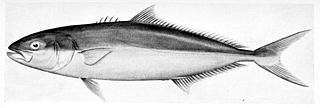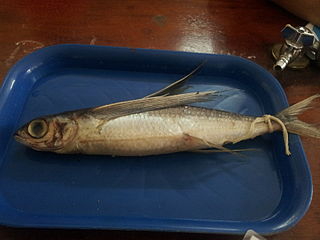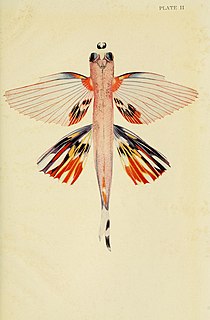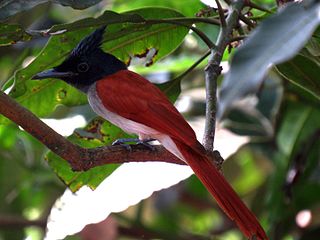
The swamp harrier, also known as the Australasian marsh harrier, Australasian harrier, kāhu, swamp-hawk or New Zealand hawk, is a large, slim bird of prey widely distributed across Australasia. It is one of the few birds to have benefited from European settlement of New Zealand: It is a bird of open country and became firmly established in New Zealand after forests were cleared by Polynesians.

The Exocoetidae are a family of marine fish in the order Beloniformes class Actinopterygii, known colloquially as flying fish. About 64 species are grouped in seven to nine genera. While they cannot fly in the same way as a bird does, flying fish can make powerful, self-propelled leaps out of water where their long wing-like fins enable gliding for considerable distances above the water's surface. The Exocet missile is named after them, as variants are launched from underwater, and take a low trajectory, skimming the surface, before striking their prey.

The Australasian gannet, also known as Australian gannet and tākapu, is a large seabird of the booby and gannet family, Sulidae. Adults are mostly white, with black flight feathers at the wingtips and lining the trailing edge of the wing. The central tail feathers are also black. The head is tinged buff-yellow, with a pale blue-grey bill edged in black, and blue-rimmed eyes. Young birds have mottled plumage in their first year, dark above and light below. The head is an intermediate mottled grey, with a dark bill. The birds gradually acquire more white in subsequent seasons until they reach maturity after five years.

Rodney Wilfred Heath was an Australian tennis player.

The southern yellowtail amberjack, yellowtail kingfish or great amberjack is a large fish found in the Southern Ocean. Although previously thought to be found in all oceans and seas, recent genetic analysis restricts S. lalandi proper to the Southern Hemisphere waters. However, they are found in northern hemisphere waters during certain times of the year.
Deania is a genus of long-snouted, deepwater dogfish sharks in the family Centrophoridae.

The New Zealand black angelfish or the black scalyfin, Parma alboscapularis, is a damselfish of the family Pomacentridae, found around northeastern New Zealand to depths of a few metres, over shallow rocky reef areas. Its length is between 24 and 28 cm.

The New Zealand sole or common sole, Peltorhamphus novaezeelandiae, is a righteye flounder of the genus Peltorhamphus, found around New Zealand in shallow enclosed waters less than 100 m in depth. Their length is from 25 to 45 cm.

The longnose spurdog is a dogfish shark of the genus Squalus, found over continental shelves in all oceans, at depths of between 15 and 800 metres. They reach one metre in length.

The New Zealand turbot, Colistium nudipinnis, is a righteye flounder of the subfamily Rhombosoleinae in the family Pleuronectidae, found around New Zealand in shallow enclosed waters. Their length is from 25 to 90 cm, and they are the largest flounder in New Zealand.

The Australasian snapper or silver seabream, is a species of porgie found in coastal waters of Australia, Philippines, Indonesia, China, Taiwan, Japan and New Zealand. Its distribution areas in the Northern and Southern Hemispheres are disjunct. Although it is almost universally known in Australia and New Zealand as snapper, it does not belong to the Lutjanidae family of snappers. It is highly prized as an eating fish.

The giant stargazer, Kathetostoma giganteum, is a stargazer of the family Uranoscopidae, found on the continental shelf around New Zealand and endemic to that area.

Cheilopogon is a genus of flyingfishes.
Crapatalus angusticeps, the slender stargazer, is a species of southern sandfish endemic to the Pacific waters around New Zealand. It can be found at depths between a few and 60 m.
The New Zealand flathead, Bembrops morelandi, is a duckbill of the family Percophidae, subfamily Bembropinae, found only around New Zealand, at depths between 365 and 395 m. Their length is up to 20 cm.

Cheilopogon pinnatibarbatus japonicus is a subspecies of flyingfish of the family Exocoetidae, found in the seas around Japan. Its length is up to 50 cm.
The California flying fish, Cheilopogon pinnatibarbatus californicus, is a subspecies of Pacific flying fish. It may grow up to 15 inches (38 cm) in length and is the largest member of the flying fish family. It is found in the Eastern Pacific Ocean, from Oregon to Baja California. As with all other flying fish, the California can not actually fly, but it can launch itself into the air, using its specially adapted fins to glide along the surface.

The Atlantic flyingfish is a flying fish in the family Exocoetidae. It was first described by the French zoologist, Achille Valenciennes in a 22-volume work entitled Histoire naturelle des poissons, which was a collaboration with fellow zoologist Georges Cuvier.

Cheilopogon nigricans, the blacksail flyingfish, also known as African flyingfish, or leaping flyingfish, is a flying fish in the family Exocoetidae. It is an oceanodromous, plankton-eating marine fish which has commercial value.

The spotfin flyingfish, Cheilopogon furcatus, is a fish in the flying fish family, Exocoetidae.

















